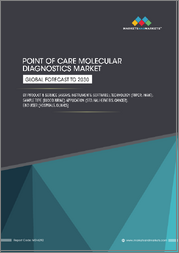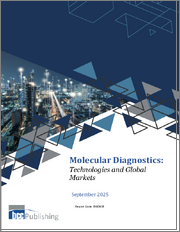
|
시장보고서
상품코드
1609690
일본의 분자진단 시장 보고서 : 제품, 기술, 용도, 최종사용자, 지역별(2025-2033년)Japan Molecular Diagnostics Market Report by Product, Technology (Polymerase Chain Reactions, Hybridization, DNA Sequencing, Microarray, Isothermal Nucleic Acid Amplification Technology, and Others), Application, End User, and Region 2025-2033 |
||||||
일본의 분자진단 시장 규모는 2024년 12억 달러로 추정됩니다. 향후 IMARC 그룹은 2033년에는 21억 달러에 달할 것으로 예상하며, 2025년부터 2033년까지 6%의 연평균 성장률(CAGR)을 보일 것으로 예측했습니다. 암 및 심혈관 질환과 같은 만성 질환의 유병률 증가, 고유한 건강 관리 요구와 특정 질환에 대한 높은 경향을 필요로 하는 노인 인구 증가, 차세대 시퀀싱 및 실시간 PCR과 같은 첨단 기술의 통합은 시장을 이끄는 주요 요인 중 일부입니다.
본 보고서에서 다룬 주요 질문
- 일본 분자진단 시장은 지금까지 어떤 성과를 거두었으며, 향후 몇 년동안 어떤 성과를 거둘 것인가?
- 코로나19가 일본 분자진단 시장에 미치는 영향은?
- 일본 분자진단 시장의 제품별 구성비는?
- 일본 분자진단 시장의 기술별 구성비는?
- 일본 분자진단 시장의 용도에 따른 분류는?
- 일본 분자진단 시장의 최종 사용자별 분석은?
- 일본 분자진단 시장의 밸류체인에는 어떤 단계가 있는가?
- 일본 분자진단 시장의 주요 촉진요인과 과제는?
- 일본 분자진단 시장의 구조와 주요 기업은?
- 일본 분자진단 시장의 경쟁은 어느 정도인가?
목차
제1장 서문
제2장 조사 범위와 조사 방법
- 조사 목적
- 이해관계자
- 데이터 소스
- 시장 추정
- 조사 방법
제3장 주요 요약
제4장 일본의 분자진단 시장 : 서론
- 개요
- 시장 역학
- 업계 동향
- 경쟁 정보
제5장 일본의 분자진단 시장 구도
- 과거 및 현재 시장 동향(2019-2024년)
- 시장 예측(2025-2033년)
제6장 일본의 분자진단 시장 : 제품별 분석
- 시약 및 키트
- 기기
- 소프트웨어 및 서비스
제7장 일본의 분자진단 시장 : 기술별 분석
- 중합효소 연쇄반응(PCR)
- 교배
- DNA 배열 분석
- 마이크로어레이
- 등온 핵산 증폭 기술(INAAT)
- 기타
제8장 일본의 분자진단 시장 : 용도별 분석
- 감염증 진단
- 종양학
- 유전자 검사
- 혈액 검사
- 기타
제9장 일본의 분자진단 시장 : 최종사용자별 분석
- 병원
- 실험실
- 기타
제10장 일본의 분자진단 시장 : 경쟁 구도
- 개요
- 시장 구조
- 시장 기업 포지셔닝
- 주요 성공 전략
- 경쟁 대시보드
- 기업 평가 상한
제11장 주요 기업 개요
제12장 일본의 분자진단 시장 : 업계 분석
- 성장 촉진요인 및 억제요인과 기회
- Porter의 Five Forces 분석
- 밸류체인 분석
제13장 부록
LSH 24.12.23The Japan molecular diagnostics market size reached USD 1.2 Billion in 2024. Looking forward, IMARC Group expects the market to reach USD 2.1 Billion by 2033, exhibiting a growth rate (CAGR) of 6% during 2025-2033. The increasing prevalence of chronic diseases, including cancer and cardiovascular ailments, the growing geriatric population requiring unique healthcare needs and a higher propensity for specific diseases, and the integration of advanced technologies such as next-generation sequencing and real-time PCR represent some of the key factors driving the market.
Molecular diagnostics refers to a collection of techniques used to analyze biological markers in the genome and proteome. This category of diagnostics enables medical professionals to detect and measure the presence of genetic material or proteins associated with a specific health condition or disease state. Molecular diagnostics are characterized by their precision, accuracy, and speed, as well as their essential role in the healthcare system. These diagnostic methods employ technologies such as PCR (polymerase chain reaction), ISH (in situ hybridization), and DNA sequencing to uncover specific genetic information. Their working mechanism involves extracting, amplifying, and analyzing genetic material, starting with the isolation of DNA or RNA to amplify targeted genetic regions. The amplified genetic material is then examined through various methods to identify mutations or changes, enabling healthcare providers to make informed decisions about diagnosis and treatment. The properties of molecular diagnostics such as sensitivity, specificity, and the ability to process multiple samples simultaneously make them advantageous in providing timely and tailored medical treatments, thereby offering a promising system to personalized medicine.
Japan Molecular Diagnostics Market Trends:
The market in Japan is primarily driven by the increasing prevalence of chronic diseases, including cancer and cardiovascular ailments, which necessitates the need for early and precise detection. In line with this, the growing geriatric population in Japan, requiring unique healthcare needs and a higher propensity for specific diseases, is also providing an impetus to the market. Moreover, the integration of advanced technologies such as next-generation sequencing and real-time PCR is acting as a significant growth-inducing factor for the market. In addition to this, the consistent support from the Japanese government in terms of funding and favorable regulatory guidelines is resulting in a more conducive environment for research and development. Besides this, the growing awareness about personalized medicine, coupled with a strong emphasis on research collaboration between academic institutions and private enterprises, is creating lucrative opportunities in the market. Also, the wide availability of molecular diagnostic platforms across various healthcare settings is impacting the market positively. The market is further driven by the robust investment in healthcare infrastructure and the strategic alignment of public health goals with technological innovation. Apart from this, the penetration of health insurance, focusing on preventive care and early diagnosis, along with the proliferation of specialized laboratories and clinics, is propelling the market. Some of the other factors contributing to the market include Japan's highly educated workforce, sophisticated healthcare system, and a cultural emphasis on precision and innovation in medical science and technology.
Japan Molecular Diagnostics Market Segmentation:
Product Insights:
- Reagents and Kits
- Instruments
- Software and Services
Technology Insights:
- Polymerase Chain Reactions (PCR)
- Hybridization
- DNA Sequencing
- Microarray
- Isothermal Nucleic Acid Amplification Technology (INAAT)
- Others
Application Insights:
- Infectious Diseases Diagnostics
- Oncology
- Genetic Testing
- Blood Screening
- Others
End User Insights:
- Hospitals
- Laboratories
- Others
Competitive Landscape:
- The report has also provided a comprehensive analysis of the competitive landscape in the market. Competitive analysis such as market structure, key player positioning, top winning strategies, competitive dashboard, and company evaluation quadrant has been covered in the report. Also, detailed profiles of all major companies have been provided.
Key Questions Answered in This Report:
- How has the Japan molecular diagnostics market performed so far and how will it perform in the coming years?
- What has been the impact of COVID-19 on the Japan molecular diagnostics market?
- What is the breakup of the Japan molecular diagnostics market on the basis of product?
- What is the breakup of the Japan molecular diagnostics market on the basis of technology?
- What is the breakup of the Japan molecular diagnostics market on the basis of application?
- What is the breakup of the Japan molecular diagnostics market on the basis of end user?
- What are the various stages in the value chain of the Japan molecular diagnostics market?
- What are the key driving factors and challenges in the Japan molecular diagnostics market?
- What is the structure of the Japan molecular diagnostics market and who are the key players?
- What is the degree of competition in the Japan molecular diagnostics market?
Table of Contents
1 Preface
2 Scope and Methodology
- 2.1 Objectives of the Study
- 2.2 Stakeholders
- 2.3 Data Sources
- 2.3.1 Primary Sources
- 2.3.2 Secondary Sources
- 2.4 Market Estimation
- 2.4.1 Bottom-Up Approach
- 2.4.2 Top-Down Approach
- 2.5 Forecasting Methodology
3 Executive Summary
4 Japan Molecular Diagnostics Market - Introduction
- 4.1 Overview
- 4.2 Market Dynamics
- 4.3 Industry Trends
- 4.4 Competitive Intelligence
5 Japan Molecular Diagnostics Market Landscape
- 5.1 Historical and Current Market Trends (2019-2024)
- 5.2 Market Forecast (2025-2033)
6 Japan Molecular Diagnostics Market - Breakup by Product
- 6.1 Reagents and Kits
- 6.1.1 Overview
- 6.1.2 Historical and Current Market Trends (2019-2024)
- 6.1.3 Market Forecast (2025-2033)
- 6.2 Instruments
- 6.2.1 Overview
- 6.2.2 Historical and Current Market Trends (2019-2024)
- 6.2.3 Market Forecast (2025-2033)
- 6.3 Software and Services
- 6.3.1 Overview
- 6.3.2 Historical and Current Market Trends (2019-2024)
- 6.3.3 Market Forecast (2025-2033)
7 Japan Molecular Diagnostics Market - Breakup by Technology
- 7.1 Polymerase Chain Reactions (PCR)
- 7.1.1 Overview
- 7.1.2 Historical and Current Market Trends (2019-2024)
- 7.1.3 Market Forecast (2025-2033)
- 7.2 Hybridization
- 7.2.1 Overview
- 7.2.2 Historical and Current Market Trends (2019-2024)
- 7.2.3 Market Forecast (2025-2033)
- 7.3 DNA Sequencing
- 7.3.1 Overview
- 7.3.2 Historical and Current Market Trends (2019-2024)
- 7.3.3 Market Forecast (2025-2033)
- 7.4 Microarray
- 7.4.1 Overview
- 7.4.2 Historical and Current Market Trends (2019-2024)
- 7.4.3 Market Forecast (2025-2033)
- 7.5 Isothermal Nucleic Acid Amplification Technology (INAAT)
- 7.5.1 Overview
- 7.5.2 Historical and Current Market Trends (2019-2024)
- 7.5.3 Market Forecast (2025-2033)
- 7.6 Others
- 7.6.1 Historical and Current Market Trends (2019-2024)
- 7.6.2 Market Forecast (2025-2033)
8 Japan Molecular Diagnostics Market - Breakup by Application
- 8.1 Infectious Diseases Diagnostics
- 8.1.1 Overview
- 8.1.2 Historical and Current Market Trends (2019-2024)
- 8.1.3 Market Forecast (2025-2033)
- 8.2 Oncology
- 8.2.1 Overview
- 8.2.2 Historical and Current Market Trends (2019-2024)
- 8.2.3 Market Forecast (2025-2033)
- 8.3 Genetic Testing
- 8.3.1 Overview
- 8.3.2 Historical and Current Market Trends (2019-2024)
- 8.3.3 Market Forecast (2025-2033)
- 8.4 Blood Screening
- 8.4.1 Overview
- 8.4.2 Historical and Current Market Trends (2019-2024)
- 8.4.3 Market Forecast (2025-2033)
- 8.5 Others
- 8.5.1 Historical and Current Market Trends (2019-2024)
- 8.5.2 Market Forecast (2025-2033)
9 Japan Molecular Diagnostics Market - Breakup by End User
- 9.1 Hospitals
- 9.1.1 Overview
- 9.1.2 Historical and Current Market Trends (2019-2024)
- 9.1.3 Market Forecast (2025-2033)
- 9.2 Laboratories
- 9.2.1 Overview
- 9.2.2 Historical and Current Market Trends (2019-2024)
- 9.2.3 Market Forecast (2025-2033)
- 9.3 Others
- 9.3.1 Historical and Current Market Trends (2019-2024)
- 9.3.2 Market Forecast (2025-2033)
10 Japan Molecular Diagnostics Market - Competitive Landscape
- 10.1 Overview
- 10.2 Market Structure
- 10.3 Market Player Positioning
- 10.4 Top Winning Strategies
- 10.5 Competitive Dashboard
- 10.6 Company Evaluation Quadrant
11 Profiles of Key Players
- 11.1 Company A
- 11.1.1 Business Overview
- 11.1.2 Product Portfolio
- 11.1.3 Business Strategies
- 11.1.4 SWOT Analysis
- 11.1.5 Major News and Events
- 11.2 Company B
- 11.2.1 Business Overview
- 11.2.2 Product Portfolio
- 11.2.3 Business Strategies
- 11.2.4 SWOT Analysis
- 11.2.5 Major News and Events
- 11.3 Company C
- 11.3.1 Business Overview
- 11.3.2 Product Portfolio
- 11.3.3 Business Strategies
- 11.3.4 SWOT Analysis
- 11.3.5 Major News and Events
- 11.4 Company D
- 11.4.1 Business Overview
- 11.4.2 Product Portfolio
- 11.4.3 Business Strategies
- 11.4.4 SWOT Analysis
- 11.4.5 Major News and Events
- 11.5 Company E
- 11.5.1 Business Overview
- 11.5.2 Product Portfolio
- 11.5.3 Business Strategies
- 11.5.4 SWOT Analysis
- 11.5.5 Major News and Events
12 Japan Molecular Diagnostics Market - Industry Analysis
- 12.1 Drivers, Restraints, and Opportunities
- 12.1.1 Overview
- 12.1.2 Drivers
- 12.1.3 Restraints
- 12.1.4 Opportunities
- 12.2 Porters Five Forces Analysis
- 12.2.1 Overview
- 12.2.2 Bargaining Power of Buyers
- 12.2.3 Bargaining Power of Suppliers
- 12.2.4 Degree of Competition
- 12.2.5 Threat of New Entrants
- 12.2.6 Threat of Substitutes
- 12.3 Value Chain Analysis



















